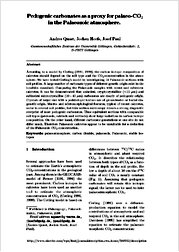Pedogenic carbonates as a proxy for palaeo-CO2 in the Palaeozoic atmosphere
Quast, Andres; Hoefs, Jochen; Paul, Josef, 2006: Pedogenic carbonates as a proxy for palaeo-CO2 in the Palaeozoic atmosphere. In: Quast, A., Hoefs, J. & Paul, J. 2006: Pedogenic carbonates as a proxy for palaeo-CO2 in the Palaeozoic atmosphere. - Palaeogeogr., Palaeoclimatol., Palaeoecol., 242, 1-2:110-125, DOI: 10.23689/fidgeo-795.
 |
Dokument öffnen: |
According to a model by Cerling (1991, 1999), the carbon isotope composition
of calcretes should depend on the soil type and the CO2-concentration in the atmosphere.
We have tested Cerling’s model by investigating 14 Palaeozoic sections with
soil profiles. A large number of carbonate types of different genetic origin exist in the
localities examined. Comparing the Palaeozoic samples with recent and subrecent
calcretes, it can be demonstrated that anhedral, cryptocrystalline (<10 μm) and
subhedral microcrystalline (10 - 40 μm) carbonates are clearly of pedogenic origin.
Crystals of larger size with a poikilotopic texture are of groundwater or burial diagenetic
origin. Macro- and micromorphological features, typical of recent calcretes,
occur in several soil profiles, but thin section microscopy reveals a strong diagenetic
overprint of most pedogenic carbonates. Time equivalent sections with comparable
soil types (protosols, calcisols and vertisols) show large variations in carbon isotope
composition. On the other hand, different carbonate generations at one site do not
differ much. Therefore Palaeozoic calcretes appear to be unsuitable for a deduction
of the Palaeozoic CO2-concentration.
Statistik:
ZugriffsstatistikSammlung:
Schlagworte:
KohlenstoffkreislaufC-isotope
Jungpaläozoikum
Paläopedologie
Kalkkruste
CO2
calcrete
carbon cycle
upper Paleozoic
paleosol
C-13/C-12
Europa
paläoklima
Europe
Lithogenese {Sedimentologie}
Geochemie der Stabilen Isotopen
Paläozoische Geologie
Sedimentationsbedingungen
Petrogenese
Klastische Sedimentgesteine
Europa insgesamt {Geologie}
Karbonatische Sedimentgesteine

